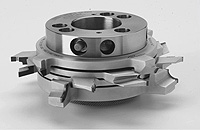What is Polycrystalline Diamond (PCD)?
Polycrystalline Diamond is a synthesized, extremely durable intergrown group of randomly placed diamond particles, which are bound to a tungsten carbide substrate. Just think of very fine diamond particles, micron rated, held together with a cobalt binder and then pressed onto a layer of carbide. This process is performed under extreme pressure and high temperature.
Where can PCD be used successfully?
PCD is commonly used on non-ferrous materials such as aluminum, copper, brass, bronze, and some powdered metals, as well as highly abrasive engineered wood such as MDF, some Particle board, and some hardwoods. PCD is also the cutting material of choice for plastics, fiberglass, molding compounds, carbon fiber, and phenolics as commonly used in the Automotive and Aerospace industry. Due to PCD’s exceptional lifespan of each cutting edge, cutting tools are replaced less frequently. This results in fewer opportunities for operator error and substantially increases your cutting time.
Benefits of PCD Tooling
Diamond tooling is most appropriate for large production runs on homogenous materials where tight tolerances and consistency is required. Longer lasting cutting edges dramatically increase run times, resulting in fewer tool changes and increased productivity. This helps to reduce tool costs as well as the cost per part to be manufactured. Diamond tooling wear characteristics allow for tighter tolerances and superior surface finishes for longer periods and in many cases increased cycle times. When compared with tungsten carbide, diamond tools often provide an increased run-time of up to 300 times.
Limitations / Downside of PCD tooling
PCD diamond tooling is very wear resistant but is not impact resistant. It chips fairly easily when there is contamination within the substrate or with improper handling. Knots in the wood or foreign matter can cause damage to the edge. PCD is not recommended for soft woods such as pine or poplar. Particle board from some manufacturers has rocks, sand, glass, metal, and other foreign matter mixed in – this can cause severe damage to the edge and dramatically reduce the life of the tool.
It is also critical that the machine be in top running condition. There should be sufficient hold-down capacity and dust collection. Material movement can damage the head. Run-out will dramatically reduce life and quality of the edge.
Edge of Arlington can assist you in determining if PCD tooling is appropriate and cost effective for you.



